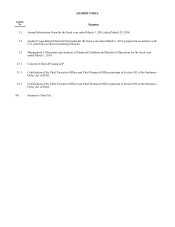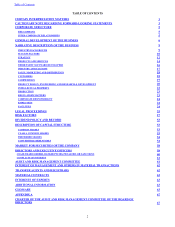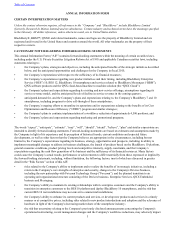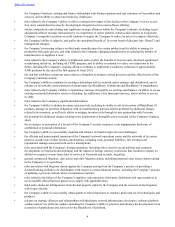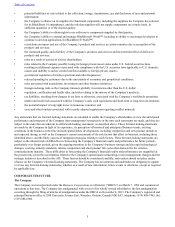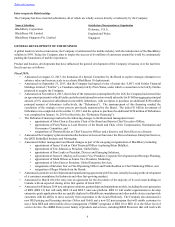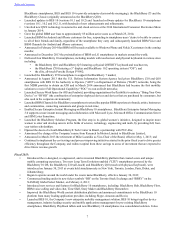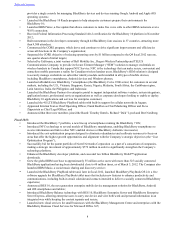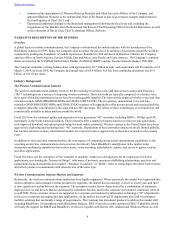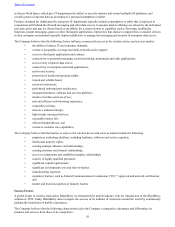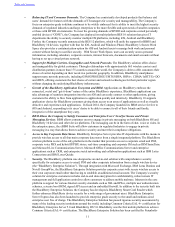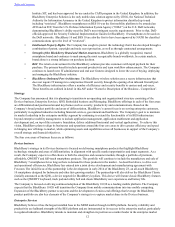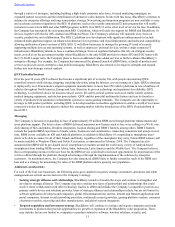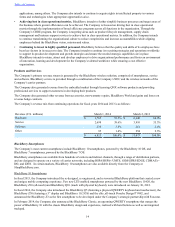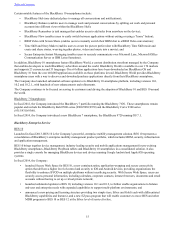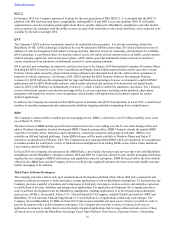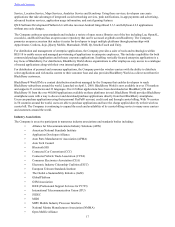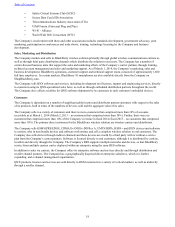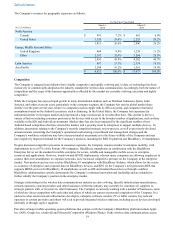Blackberry 2014 Annual Report Download - page 17
Download and view the complete annual report
Please find page 17 of the 2014 Blackberry annual report below. You can navigate through the pages in the report by either clicking on the pages listed below, or by using the keyword search tool below to find specific information within the annual report.
9
• Announced the appointment of Thorsten Heins as President and Chief Executive Officer of the Company, and
appointed Barbara Stymiest as the independent Chair of the Board as part of governance changes implemented in
the fourth quarter of fiscal 2012; and
• Experienced additional changes to the Board and management following the fiscal year end, including the
resignations of Jim Balsillie from the Board and Jim Rowan, Chief Operating Officer for Global Operations, as well
as the retirement of David Yach, Chief Technology Officer, Software.
NARRATIVE DESCRIPTION OF THE BUSINESS
Overview
A global leader in mobile communications, the Company revolutionized the mobile industry with the introduction of the
BlackBerry solution in 1999. Today, the Company aims to inspire the success of its millions of customers around the world by
continuously pushing the boundaries of mobile experiences. Founded in 1984 and based in Waterloo, Ontario, the Company
operates offices in North America, Europe, Middle East and Africa, Asia Pacific and Latin America. The Company’s common
shares are listed on the NASDAQ Global Select Market (NASDAQ: BBRY) and the Toronto Stock Exchange (TSX: BB).
The Company maintains a strong balance sheet with approximately $2.7 billion in cash, cash equivalents and investments as of
March 1, 2014. In fiscal 2014, the Company had annual sales of $6.8 billion. Net loss from continuing operations was $5.9
billion, or $11.18 per share.
Industry Background
The Wireless Communications Industry
The wireless communications industry involves the provisioning of wireless voice and data services using radio frequency
(“RF”) technologies on a variety of competing wireless networks. These networks are typically comprised of a distinct voice
layer upon which data transmission layers have been subsequently installed. The most widely deployed wireless voice and data
networks include GSM/GPRS/EDGE/HSPA and CDMA/1xRTT/EVDO. The two primary international voice and data
networks GSM/GPRS/EDGE/HSPA and CDMA/EVDO continue to be upgraded to offer greater speeds and increased abilities
to support subscriber concentration in the same and new RF spectrums. The rollout of these technologies is well underway and
commercially available in many markets around the world.
Fiscal 2014 saw the continued uptake and expansion of next generation “4G” networks, including HSPA+, WiMax and LTE,
particularly in the North American markets. These networks offer a number of improvements over the previous generations,
with improved download and upload speeds being the most widely promoted. Wireless carriers in the United States have been
aggressively deploying and marketing these “4G” networks. Deployment of these networks remains relatively limited globally,
but wireless operators in many international markets are expected to move aggressively to these new networks in the coming
years.
In addition to voice and data communications, the convergence of computing and personal entertainment capabilities is also
occurring on wireless communications devices across the industry. Most BlackBerry smartphones in the market today
incorporate multimedia capabilities that include music, video recording and playback, camera, and access to games, content
and other applications.
Fiscal 2014 also saw the emergence of the “machine to machine” market as a driving force for the expansion of wireless
applications, accelerating the “Internet of things”, with many, if not most, operators establishing relationships, practices and
partnerships focused around this new market. “Machine to machine” or “M2M”, refers to technologies that allow both wireless
and wired systems to communicate with other devices of the same type.
Wireless Communications Industry Markets and Segments
Historically, the wireless communications market has been highly segmented. Where previously the market was segmented into
distinct enterprise and consumer/extreme productivity segments, the market has increasingly evolved in recent years and there
is now significant overlap between the segments. The enterprise market is now characterized by a combination of enterprise-
deployed devices and devices that are purchased by consumers but also used in the corporate environment, commonly referred
to as BYOD. These consumer devices are supported in a corporate environment by information technology (“IT”) departments
for access to corporate messaging and data applications. As the market has evolved, IT departments now look for enterprise
mobility solutions that can handle a range of requirements. The Company has introduced products to address this market shift
including BlackBerry 10 smartphones with BlackBerry Balance, BES 10 and the recently announced BES 12 platform, which
will unify the support for BBOS and BlackBerry 10 devices, together with that for iOS, Android and Windows Phone, as well
Table of Contents



